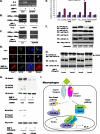Induction of interleukin-6 expression by bone morphogenetic protein-6 in macrophages requires both SMAD and p38 signaling pathways
- PMID: 20889504
- PMCID: PMC2998138
- DOI: 10.1074/jbc.M110.103705
Induction of interleukin-6 expression by bone morphogenetic protein-6 in macrophages requires both SMAD and p38 signaling pathways
Abstract
Unlike the prototype transforming growth factor-β (TGF-β), bone morphogenetic protein-6 (BMP-6) activates macrophages. Here, we report that BMP-6 induces the expression of IL-6 in macrophages. Using overexpression and knockdown experiments, we demonstrate that BMP receptor type II and activin-like kinase-2 are necessary for IL-6 induction by BMP-6. At the intracellular level, both Smad and p38 signaling pathways are required for the induction of IL-6. The cross-talk between the two pathways occurs at the level of transcription factor GATA4 and Smad 1/4. These results, taken together, demonstrate a novel BMP-6 signaling mechanism in which both the Smad and non-Smad pathways directly interact to activate the transcription of a target gene.
Figures





Similar articles
-
Bone morphogenetic protein 6-induced interleukin-1β expression in macrophages requires PU.1/Smad1 interaction.Mol Immunol. 2011 Jul;48(12-13):1540-7. doi: 10.1016/j.molimm.2011.04.019. Epub 2011 May 14. Mol Immunol. 2011. PMID: 21571370
-
Transforming growth factor-β stimulates Smad1/5 signaling in pulmonary artery smooth muscle cells and fibroblasts of the newborn mouse through ALK1.Am J Physiol Lung Cell Mol Physiol. 2017 Sep 1;313(3):L615-L627. doi: 10.1152/ajplung.00079.2017. Epub 2017 Jun 22. Am J Physiol Lung Cell Mol Physiol. 2017. PMID: 28642261 Free PMC article.
-
Role of bone morphogenetic proteins in sprouting angiogenesis: differential BMP receptor-dependent signaling pathways balance stalk vs. tip cell competence.FASEB J. 2017 Nov;31(11):4720-4733. doi: 10.1096/fj.201700193RR. Epub 2017 Jul 21. FASEB J. 2017. PMID: 28733457 Free PMC article.
-
Bone morphogenetic proteins.Growth Factors. 2004 Dec;22(4):233-41. doi: 10.1080/08977190412331279890. Growth Factors. 2004. PMID: 15621726 Review.
-
Altered Bone Morphogenetic Protein 2 Signaling Causes Age-Dependent Decline in Gut Motility Independent of Muscularis Macrophages.Gastro Hep Adv. 2025 Apr 11;4(7):100673. doi: 10.1016/j.gastha.2025.100673. eCollection 2025. Gastro Hep Adv. 2025. PMID: 40503185 Free PMC article. Review. No abstract available.
Cited by
-
BMP-6 promotes type 2 immune response during enhancement of rat mandibular bone defect healing.Front Immunol. 2023 Feb 10;14:1064238. doi: 10.3389/fimmu.2023.1064238. eCollection 2023. Front Immunol. 2023. PMID: 36845161 Free PMC article.
-
Feibi decoction-medicated serum inhibits lipopolysaccharide-induced inflammation in RAW264.7 cells and BMDMs.Exp Ther Med. 2022 Jan;23(1):110. doi: 10.3892/etm.2021.11033. Epub 2021 Dec 2. Exp Ther Med. 2022. PMID: 34976152 Free PMC article.
-
Immunoregulation by members of the TGFβ superfamily.Nat Rev Immunol. 2016 Nov 25;16(12):723-740. doi: 10.1038/nri.2016.112. Nat Rev Immunol. 2016. PMID: 27885276 Review.
-
Bone Morphogenetic Proteins in Vascular Homeostasis and Disease.Cold Spring Harb Perspect Biol. 2018 Feb 1;10(2):a031989. doi: 10.1101/cshperspect.a031989. Cold Spring Harb Perspect Biol. 2018. PMID: 28348038 Free PMC article. Review.
-
Adverse effects of BMPR2 suppression in macrophages in animal models of pulmonary hypertension.Pulm Circ. 2019 May 24;10(1):2045894019856483. doi: 10.1177/2045894019856483. Online ahead of print. Pulm Circ. 2019. PMID: 31124398 Free PMC article.
References
-
- Wozney J. M., Rosen V., Celeste A. J., Mitsock L. M., Whitters M. J., Kriz R. W., Hewick R. M., Wang E. A. (1988) Science 242, 1528–1534 - PubMed
-
- Zhao G. Q. (2003) Genesis 35, 43–56 - PubMed
-
- Miyazono K., Maeda S., Imamura T. (2005) Cytokine Growth Factor Rev. 16, 251–263 - PubMed
-
- Kretzschmar M., Massagué J. (1998) Curr. Opin. Genet. Dev. 8, 103–111 - PubMed
Publication types
MeSH terms
Substances
LinkOut - more resources
Full Text Sources

